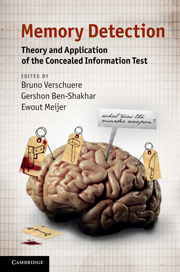Book contents
- Frontmatter
- Contents
- List of figures
- List of tables
- Notes on contributors
- Acknowledgments
- Part I Introduction
- Part II The laboratory: theoretical and empirical foundations of the Concealed Information Test
- 2 Detecting concealed information using autonomic measures
- 3 Detecting concealed information in less than a second: response latency-based measures
- 4 P300 in detecting concealed information
- 5 Detecting of deception and concealed information using neuroimaging techniques
- 6 New and old covert measures in the Concealed Information Test
- 7 Theory of the Concealed Information Test
- Part III Field applications of concealed information detection: promises and perils
- Part IV Conclusions
- Index
- References
4 - P300 in detecting concealed information
Published online by Cambridge University Press: 05 June 2012
- Frontmatter
- Contents
- List of figures
- List of tables
- Notes on contributors
- Acknowledgments
- Part I Introduction
- Part II The laboratory: theoretical and empirical foundations of the Concealed Information Test
- 2 Detecting concealed information using autonomic measures
- 3 Detecting concealed information in less than a second: response latency-based measures
- 4 P300 in detecting concealed information
- 5 Detecting of deception and concealed information using neuroimaging techniques
- 6 New and old covert measures in the Concealed Information Test
- 7 Theory of the Concealed Information Test
- Part III Field applications of concealed information detection: promises and perils
- Part IV Conclusions
- Index
- References
Summary
Overview: This chapter reviews the use of the P300 ERP in the detection of concealed information since the first published papers in the late 1980s. First, there is a description of P300 as a cortical signal of the recognition of meaningful information. This attribute was applied directly to concealed information detection in the first P300-based CIT protocol called the “three stimulus protocol.” There follows a detailed discussion and review of the methods of analysis used to determine guilt or innocence with the P300, as well as the major papers using and extending the three stimulus protocol in areas beyond those reported in the first publications. This discussion closes with the problematic findings showing that the P300-based, three stimulus protocol is vulnerable to countermeasures. The author's theoretical efforts to understand countermeasure vulnerability with this protocol are then described, followed by an introduction of the theoretically based novel protocol (called the Complex Trial Protocol or CTP) developed to resist countermeasures to P300-based CITs. The use of the CTP in detecting self-referring as well as incidentally acquired information (e.g., in a mock crime scenario) are described, as well as its recent use in detection of details of planned acts of terror prior to actual criminal acts. The use of reaction time as well as a novel ERP component called P900 for detecting countermeasures is also described. The chapter concludes with some caveats about remaining research issues.
- Type
- Chapter
- Information
- Memory DetectionTheory and Application of the Concealed Information Test, pp. 63 - 89Publisher: Cambridge University PressPrint publication year: 2011
References
- 40
- Cited by



